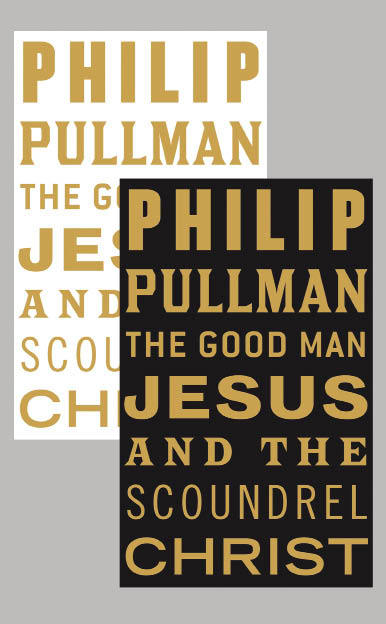Philip Pullman’s trilogy, His Dark Materials, is one the best works written in English in my lifetime.
Philip Pullman’s trilogy, His Dark Materials, is one the best works written in English in my lifetime. He is a truly great storyteller, and the details of his myth, as well as the rich gallery of characters, live forever in the reader’s memory. It upset many religious readers, especially in America, because of the fact that the central villainy of the Gobblers, child-stealers controlled by the Magisterium, are a Blake-inspired vision of Church Christians. (And rather a prophetic picture of what is now revealed on a daily basis in the papers about the activities of the Roman Catholic clergy).
No reader of his trilogy will be surprised by the fact that in his latest book, in which Pullman retells the narratives of the Gospels (apocryphal and canonical), he departs from Christian orthodoxy in a very Blakean direction. Jesus is the heroic visionary who gets crucified for his bold and liberating preaching. Christ is his rather sinister elder brother. In Pullman’s version, he is the elder brother in the prodigal son (old St Joseph is the father) who resents the favour given to the sibling who has broken all the rules. Jesus is born as a result of his 16-year-old mother, Mary, allowing an ‘angel’ into her bedroom while her elderly husband is absent. Christ is the ‘religious’ one who has yielded to all the temptations of Dostoevsky’s Grand Inquisitor. Lurking in the Garden where his brother’s crucified body is stolen from the Tomb, ‘Christ’ — before it is yet light — bumps into Mary Magdalen, and tells her that she must not touch him because he has not yet ascended to the Father. He thereby unlooses a chain of superstitious beliefs about the resurrection.
As you would expect from Pullman, the exercise is conducted with great skill. On the back of the book-jacket are inscribed the words, picked out in gold capitals, THIS IS A STORY. The implication is that, since most of the book is a retelling of the already-existent Gospel narratives, they are no more than ‘stories’. The further implication, of course, is that Christianity is a myth, worked up by the Magisterium, which has grossly distorted the revolutionary and simple teachings of that tragic prophet, Jesus.
This, very broadly, was the view of Christian- ity which was taught by many Christian divines when I studied theology at Oxford. It was assumed that the 19th-century Lives of Jesus, such as Renan’s, though sentimental in appeal, had more or less the right idea — that a simple Jewish prophet had had his words distorted by Saint Paul and made into a mystery cult for gentiles. This Victorian view of things resurfaces in the life-work of the great Dead Sea Scrolls scholar, Geza Vermes, whose Jesus the Jew is really Renan rechauffé.
Like many ‘reasonable’ explanations, it leaves out of account all the great puzzles (historical and interpretative) of the Bible. Pullman has invented a character, called ‘Christ’ to survive the death of Jesus, and to promote Magisterium-style fake consolations — that we can feed on Jesus in the Eucharist, or that we shall survive death. While not forgetting that this is only a story, and not a piece of theological propaganda, one is bound to notice that Pullman — precisely because he is such a good story-teller — has only exacerbated the unbeliever’s difficulty.
We all know that Pullman’s ‘Christ’ is an invented character. Remove him, and you are left with the puzzle. Who did meet Mary of Magdala in the Garden on the first Easter Day? Who appeared to the Twelve three times? Who appeared (in the testimony of Paul written only 20 years after the event to over 500 people in Jerusalem after the Crucifixion? Was it a phantom? Was it a fake? Were they lying? Quite possibly, of course. But then you have to wonder why those who concocted the fake were prepared to spend uncomfortable lives as missionaries, undergoing shipwrecks, persecutions and stoning, preaching this illusion so ardently; and why or how they found the courage to die heroic martyrs’ deaths defending this ‘lie’?
If Pullman’s version provides no answer to this puzzle, nor does his ‘story’ explain how — perhaps as early as the 40s, only a decade after the departure of the earthly Jesus, Christians had a hymn in which they proclaimed that at His name every knee should bow and every tongue confess that he was lord of all. If you think about these matters calmly and rationally, the apparently reasonable explanations — that the disciples, or St Paul, for some reason or other invented Christianity in defiance of Jesus’s simple Jewish faith — gradually become less and less plausible. The Gospel according to Pullman, precisely because it is so skilfully constructed, will prompt many readers to turn once more to consider whether or not they should accept the apparently bizarre testimony of the early Christian witnesses, testimony which they repeatedly insisted was not simply a ‘story’ but was based on factual experience.






Comments